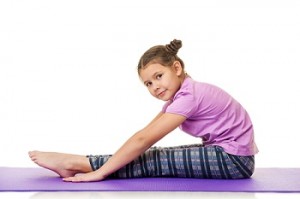Stretching and Activity for Children
By Dr. Virginia F. Casey, OrthoCarolina Pediatrics
 We all know that activity and exercise are essential components of a healthy lifestyle. They are particularly important for our children, because early exposure to exercise can lead to a positive habit into adulthood. As physicians, we encourage children to actively move their bodies at least one hour every day. This can take many forms: running around outside, playing tag, riding bikes or playing on a playground. Healthy activity can also come from more formal activities such as team sports, dance or karate. Participating in physical activities not only helps children grow into strong and fit adults, it also helps them concentrate better in school and succeed in almost all areas of life in those critical early years.
We all know that activity and exercise are essential components of a healthy lifestyle. They are particularly important for our children, because early exposure to exercise can lead to a positive habit into adulthood. As physicians, we encourage children to actively move their bodies at least one hour every day. This can take many forms: running around outside, playing tag, riding bikes or playing on a playground. Healthy activity can also come from more formal activities such as team sports, dance or karate. Participating in physical activities not only helps children grow into strong and fit adults, it also helps them concentrate better in school and succeed in almost all areas of life in those critical early years.
As parents, how do we know which physical activities are best for our children? The good news is almost any activity that keeps kids moving is beneficial, but there are a few tips you should keep in mind:
- Variety is extremely important.
- Formal stretching helps to avoid injury.
- At least one activity that focuses on core strength (tummy and back) is necessary.
Let’s start with why variety is so critical. Participating in different activities helps ensure more symmetric development of muscles and decreases overuse injuries by giving some muscle groups a rest while working others. For example, I see a lot of soccer players with hip flexor strains. Sometimes this occurs because the kids’ only activity is playing soccer. They play 10 hours a week and do not give their hip flexor (one of the big kicking muscles) time to rest or stay balanced with other muscle groups. I definitely do not want to pick on soccer, because my children love it, but this is an example of the narrow range of activity that applies to many sports. If we balance soccer with swimming as one possible combination, then the hips are still working hard and getting stronger, but are not using the same muscle groups over and over again. Variety helps prevent overuse injuries.
Such injuries also stem from a lack of stretching. Parents and coaches often assume that youth and flexibility provide protection from injury. That is simply not the case. Kids are actually at more risk for overuse injury due to their growing skeletons. The tendons and ligaments tend to be stronger than the growth plates, where overuse syndromes can occur. We commonly see this in the heel (Severs) and knee (Osgood-Schlatters). Fortunately, routine stretching can help prevent these problems.
I recommend that kids stretch before each organized activity, to get the blood flowing and the muscles warm. Warm-up activities should increase the heart rate without stretching the muscles too much. Jumping rope does this nicely, as does a simple jog – but not a sprint which stretches the muscles too much before they are warm. Once the muscles are warm, the kids should go through a stretching routine that hits the major muscle groups in the arms, legs and core. Only then are the kids ready to play. This may seem like a waste of time to an impatient coach who has a lot of skills to teach, but it is very important to keep the players healthy and playing at their best. Practice should conclude with a stretching routine as well. This type of injury prevention routine will help keep kids on the playing fields and out of the doctor’s office.
Finally, I want to stress the importance of core strength. Most of us already recognize that having a strong core helps prevent back injuries and improves overall function. As one example, knee pain due to patellar tracking problems can improve by building core strength. Balance and agility are related as well. There are many beneficial activities that focus on the core, including yoga, Pilates, martial arts and gymnastics.
The take-home message is to encourage your child to participate in physical activities or sports for an hour a day. Incorporate more than one sport or activity, including one that develops core strength, and encourage stretching on a regular basis. Effective exercise routines contribute to a healthier childhood with fewer overuse injuries.
Dr. Virginia F. Casey, MD, OrthoCarolina Pediatrics, is versed in all areas of pediatric orthopedic conditions, from simple strains to complex reconstructive hip surgery. Her practice includes newborns, adolescents and young adults. She has a special clinical interest in hip disorders.
This blog was produced in partnership with Charlotte Parent. Click here for the original post and other parenting resources.













